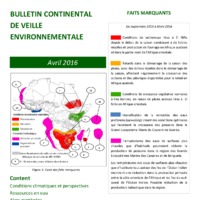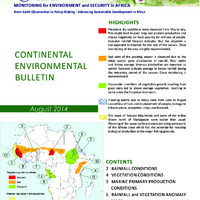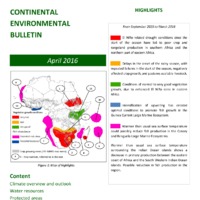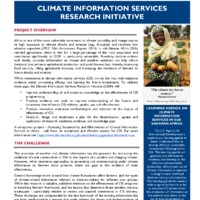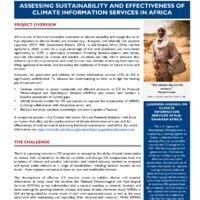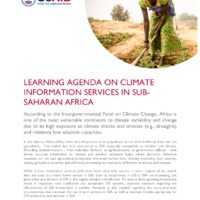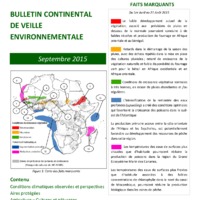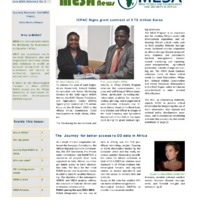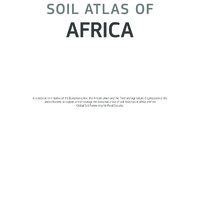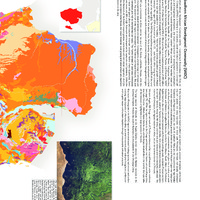Recherche
11 items
Bulletin continental de veille environnementale. Septembre 2015 à Mars 2016
Conditions de sécheresse liées à El Niño depuis le début de la saison conduisant à de faibles récoltes et production de fourrage en Afrique australe et dans la partie nord de l’Afrique orientale. Retards dans le démarrage de la saison des pluies, avec des échecs répétés dans le démarrage de la saison, affectant négativement la croissance des cultures et des pâturages disponibles pour le bétail en Afrique australe. Conditions de croissance végétative normales à très bonnes, en raison de pluies accrues liées à El Niño en Afrique orientale. Intensification de la remontée des eaux profondes (upwelling) créant des conditions optimales qui favorisent la croissance des poissons dans le Grand Ecosystème Marin du Courant de Guinée. Températures des eaux de surfaces plus chaudes que d'habitude pourraient réduire la production de poissons dans la région des Grands Ecosystèmes Marins des Canaries et de Benguela. Les températures des eaux de surfaces plus chaudes que d'habitude tout autour des îles de l’Océan Indien montrent une réduction dans la production primaire entre la côte orientale de l’Afrique et les îles du sud-ouest de l’Océan Indien. Possible réduction de la production halieutique dans la région.
Continental environmental bulletin aug 2014 en
Persistent dry conditions were observed from May to July. This might lead to poor crop and pastoral production and impact negatively on food security for millions of people. Seasonal rainfall forecast indicates that the situation is not expected to improve for the rest of the season. Close monitoring of the area is highly recommended. • Bad start of the growing season is observed due to the delay and/or poor distribution of rainfall. Poor yields and below average biomass production are expected as rainfall forecasts indicate average to below rainfall during the remaining period of the season. Close monitoring is recommended. • Favourable conditions of vegetation growth resulting from good rains led to above average vegetation, reaching in some areas the historical maximum.
Continental environmental bulletin. mesa
El Niño related drought conditions since the start of the season have led to poor crop and rangeland production in southern Africa and the northern part of eastern Africa. Delays in the onset of the rainy season, with repeated failures in the start of the season, negatively affected crop growth, and pastures available livestock. Conditions of normal to very good vegetation growth, due to enhanced El Niño rains in eastern Africa. Intensification of upwelling has created optimal conditions to promote fish growth in the Guinea Current Large Marine Ecosystem. Warmer than usual sea surface temperature could possibly reduce fish production in the Canary and Benguela Large Marine Ecosystems.
Learning agenda on cis - mercy corps two pager final
While investments in climate information services (CIS) are on the rise, little objective evidence exists concerning efficacy and learning for future investments. To address these gaps, the Climate Information Services Research Initiative (CISRI) will: • Improve understanding of, and access to, knowledge on the effectiveness of CIS programming. • Produce evidence and tools to improve understanding of the factors and structures that influence CIS delivery, uptake, use and effectiveness. • Produce innovative evaluation methodologies and evidence on the degree of effectiveness of CIS. • Research, design and implement a plan for the dissemination, uptake and application of research, synthesis, evidence, and knowledge gaps.
Learning agenda on cis - winrock two pager final
Africa is one of the most vulnerable continents to climate variability and change due to its high exposure to climate shocks and stresses (e.g., droughts) and relatively low adaptive capacities (IPCC Fifth Assessment Report, 2014). In sub-Saharan Africa (SSA) rain-fed agriculture, which is vital for a large percentage of the rural population and contributes significantly to GDP, is particularly vulnerable. Providing decision-makers with timely, accurate information on climate and weather variations can help inform decisions that enhance agricultural production and avoid harvest loss, thereby improving food security, lifting agricultural incomes, and increasing the resilience of farmers to future shocks and stresses. However, the generation and delivery of climate information services (CIS) in SSA is significantly underfunded. To advance our understanding on how to bridge the funding gap this project will: • Develop metrics to assess sustainable and effective provision of CIS by National Meteorological and Hydrological Services (NMHSs) and others, and conduct a baseline assessment of current gaps; • Identify business models for CIS and options to improve the sustainability of NMHSs including collaboration with the private sector; and • Build partnerships, synthesis knowledge, and ensure uptake of lessons.
Learning agenda on climate services overview factsheet final
In sub-Saharan Africa (SSA), more than 65 percent of the population derive their livelihood from rain-fed agriculture. This makes the rural economies in SSA especially susceptible to weather and climate. Providing decision-makers - from individual farmers, to agribusinesses, to government officials - with timely, accurate information on climate and weather variations helps inform decisions. Informed decisions can increase agricultural production and avoid harvest loss, thereby improving food security, raising agricultural incomes, and ultimately increasing the resilience of farmers to shocks and stresses. While climate information services (CIS) have been used with success in other regions of the world, they are used to a much lower extent in SSA. Even as investments in CIS in SSA are increasing, the generation and delivery of CIS in the region remains underfunded. To ensure these growing investmests result in improved rural livelihoods and sustainable CIS systems, objective evidence regarding the effectiveness of CIS investments is needed. Research is also needed regarding the socio-economic circumstances that constrain the use of such services in SSA, as well as business models appropriate for CIS production and delivery in SSA.
MESA : Bulletin continental de veille environnementale - Du 1er Avril au 21 Août 2015
Le faible développement actuel de la végétation, associé aux prévisions de pluies en dessous de la normale pourraient conduire à de faibles récoltes et production de fourrage en Afrique orientale et au Sénégal. Retards dans le démarrage de la saison des pluies, avec des échecs répétés dans la mise en place des cultures pluviales ; retard de croissance de la végétation naturelle et faible disponibilité du fourrage vert pour le bétail en Afrique occidentale et en Afrique orientale. Conditions de croissance végétative normales à très bonnes, en raison de pluies abondantes et /ou régulières.
Mesa news june
To address the issue of Land Degradation Assessment, Natural Habitat Conservation and Forest Monitoring Services in the IGAD region (MESA theme), the IGAD Climate Predictions and Applications Centre (ICPAC) Signed grant contract of 2.75 million Euros on the 03 March 2014 at the African Union Commission (AUC) Headquarters in Addis Ababa, Ethiopia.
Soil atlas of africa part 1
Arwyn Jones, European Commission Joint Research Centre, Italy (Chair); Henrik Breuning-Madsen, University of Copenhagen, Denmark; Michel Brossard, Institut de recherche pour le développement, Montpellier, France; Almami Dampha, African Union Commission, Ethiopia; Jozef Deckers, KU Leuven, Belgium; Olivier Dewitte, European Commission Joint Research Centre, Italy; Tahar Gallali, Faculté des Sciences de Tunis, Tunisia; Stephen Hallett, World Soil Survey Archive and Catalogue, Cranfield University, UK; Robert Jones, World Soil Survey Archive and Catalogue, Cranfield University, UK; Method Kilasara, Sokoine University of Agriculture, Tanzania; Pieter Le Roux, University of the Free State, South Africa; Erika Micheli, Szent Istvan University, Hungary / IUSS WRB WG; Luca Montanarella, European Commission Joint Research Centre, Italy; Otto Spaargaren, ISRIC- World Soil Information, The Netherlands; Lamourdia Thiombiano, FAO Regional Office for Africa, Ghana; Eric Van Ranst, Ghent University, Belgium; Martin Yemefack, IRAD, Cameroon; Robert Zougmoré, International Crops Research Institute for the Semi-Arid Tropics (ICRISAT), Mali.
Soil atlas of africa part 2
Arwyn Jones, European Commission Joint Research Centre, Italy (Chair); Henrik Breuning-Madsen, University of Copenhagen, Denmark; Michel Brossard, Institut de recherche pour le développement, Montpellier, France; Almami Dampha, African Union Commission, Ethiopia; Jozef Deckers, KU Leuven, Belgium; Olivier Dewitte, European Commission Joint Research Centre, Italy; Tahar Gallali, Faculté des Sciences de Tunis, Tunisia; Stephen Hallett, World Soil Survey Archive and Catalogue, Cranfield University, UK; Robert Jones, World Soil Survey Archive and Catalogue, Cranfield University, UK; Method Kilasara, Sokoine University of Agriculture, Tanzania; Pieter Le Roux, University of the Free State, South Africa; Erika Micheli, Szent Istvan University, Hungary / IUSS WRB WG; Luca Montanarella, European Commission Joint Research Centre, Italy; Otto Spaargaren, ISRIC- World Soil Information, The Netherlands; Lamourdia Thiombiano, FAO Regional Office for Africa, Ghana; Eric Van Ranst, Ghent University, Belgium; Martin Yemefack, IRAD, Cameroon; Robert Zougmoré, International Crops Research Institute for the Semi-Arid Tropics (ICRISAT), Mali.
Soil atlas of africa part 3
Arwyn Jones, European Commission Joint Research Centre, Italy (Chair); Henrik Breuning-Madsen, University of Copenhagen, Denmark; Michel Brossard, Institut de recherche pour le développement, Montpellier, France; Almami Dampha, African Union Commission, Ethiopia; Jozef Deckers, KU Leuven, Belgium; Olivier Dewitte, European Commission Joint Research Centre, Italy; Tahar Gallali, Faculté des Sciences de Tunis, Tunisia; Stephen Hallett, World Soil Survey Archive and Catalogue, Cranfield University, UK; Robert Jones, World Soil Survey Archive and Catalogue, Cranfield University, UK; Method Kilasara, Sokoine University of Agriculture, Tanzania; Pieter Le Roux, University of the Free State, South Africa; Erika Micheli, Szent Istvan University, Hungary / IUSS WRB WG; Luca Montanarella, European Commission Joint Research Centre, Italy; Otto Spaargaren, ISRIC- World Soil Information, The Netherlands; Lamourdia Thiombiano, FAO Regional Office for Africa, Ghana; Eric Van Ranst, Ghent University, Belgium; Martin Yemefack, IRAD, Cameroon; Robert Zougmoré, International Crops Research Institute for the Semi-Arid Tropics (ICRISAT), Mali.
